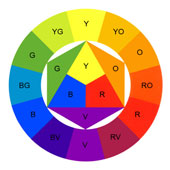Every colour is seen in relationship to another colour. When you see two or more colours together they have a profound effect on one another. The study of colour interaction helps us understand and predict how a colour will be influenced by its surroundings.
The different types of colour contrast are the following:
1. Contrast of hue
2. Light-dark contrasts
3. Cold- warm contrasts
4. Complementary contrast
5. Simultaneous contrast
6. Contrast of saturation
7. Contrast of extension
• Colour Interaction:
Contrast of Hue:
Contrast of Hue occurs when a hue or colour is separated and outlined by black or white lines. White lines weaken the 'strength' and appearance of the colour and the colours around the white lines would seem darker. Similarly, a black line strengthens the appearance of the colour and the colour around the black lines would seem lighter.

The strongest expression of contrast.

Colours of greatest luminosity.
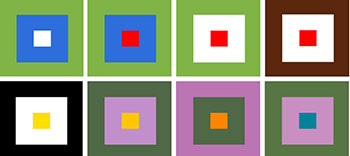
Colours of greatest luminosity with tints and shades.
Light-Dark Contrasts:
Light dark contrast is contrast between light values and dark values. The strongest expressions of light and dark are the colours white and black.
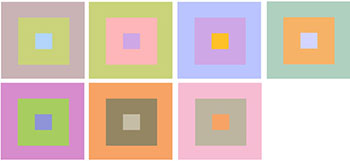
Light colour of equal brilliance.
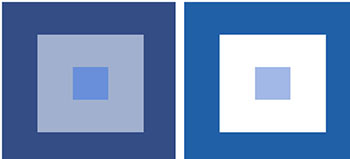
Light and dark composition in white, gray and blue.

Colours of equal darkness.
Cold - Warm Contrasts:
Cold-warm contrast refers to the contrast between cool and warm colours. Cools colours consist of blue, green and purple. Warm colours consist of red, orange and yellow. As seen in the colour wheel yellow is the lightest and violet the darkest hue; hence these two hues have the strongest light-dark contrast. Hues can be either cold or warm according to warmer or colder tones they are contrasted with.
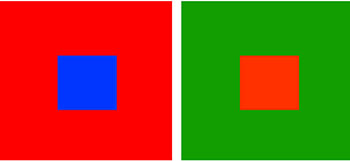
Warm - cool contrast.
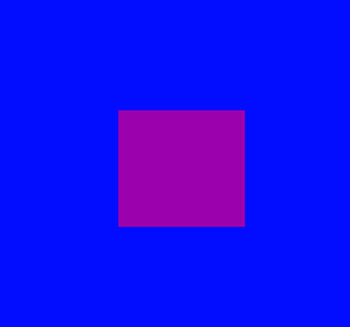
Blue as a warm.

Blue as a cool.
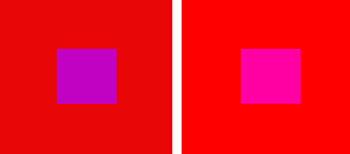
Cold warm modulation in red.

Cold warm contrast.
Complementary Contrast:
Complimentary Contrast refers to the contrast between complimentary (opposite) colours. Complimentary colours are those that are directly opposite to each other on the colour wheel. Each complementary pair has its own peculiarities. Red-orange/blue-green is a complementary pair as well as the extreme of cold warm contrast. Red and green are complementary, and the two saturated colours have the same brilliance.
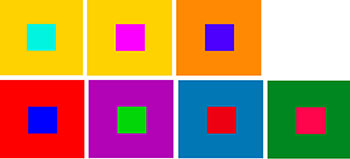
Simultaneous Contrast:
It is the contrast between a colour and another colour that is to the right of left of its compliment. Each of seven pure colour squares contains a small neutral gray square, matching the background colour in brilliance. Each gray square seems to be tinged with the complementary of the background. The simultaneous effect becomes more intense, the longer the principal colour of a square is viewed.
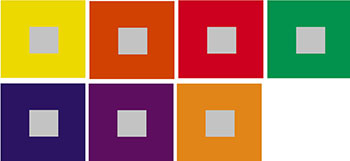
Contrast of Saturation:
It is the contrast between pure intense colours and dull diluted or grayed colours. Dull colours would appear to be duller when it is placed next to pure intense colours, and pure intense colours would appear move vivid when it is next to a dull colour.

On a checkered pattern of 3 squares, luminous yellow, orange, red, or blue is placed in the center The four corners are neutral gray in the same brilliance as the pure colour. Graded admixture of gray with the pure colour produces intermediate shades of low saturation.
Contrast of Extension:
It refers to the contrast between the proportions of one area of colour to another. Contrast of extension involves the relative areas of two or more colour patches; it is the contrast between much and little, or great and small.

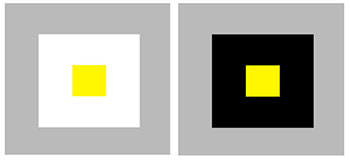
Yellow squares of equal size look bigger on white than on black.
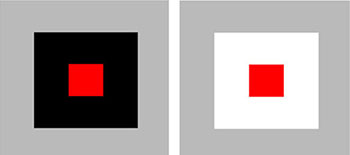
Red squares of equal size look smaller than on black.

Combinations showing how the same yellow, red and blue are altered in expression by different juxtaposed colours.
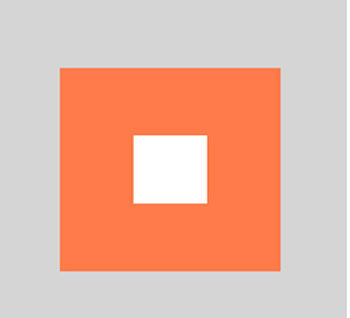
White comes up due to an orange tone.
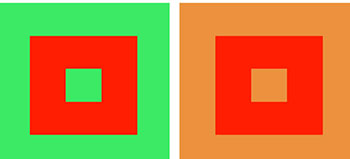
Combinations showing how the same red is altered in expression by different juxtaposed colours.

Combinations showing how the same blue with different colour.
• Colour Effects:
‘La Biennale’, a funky bar in Venice, Italy by interior designer Tobias Rehberger. Unique design patterns and many colours are used to distor t space and disguise reality.
SOURCE: Copyright © 2010 - 2011 yellowpelow.com
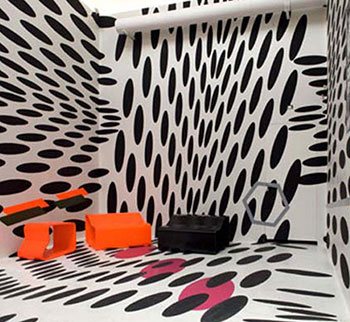
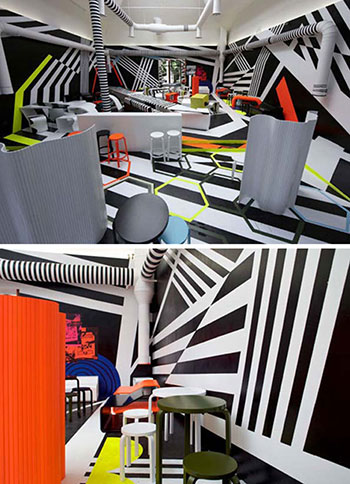
Colour Harmony:
Colour harmony is the synchronization, balance or the pleasingness of a group of colour.
Acromatic Colour Scheme:
The “hueless” colours black, gray, and white, - the whole range of gray levels between black and white.
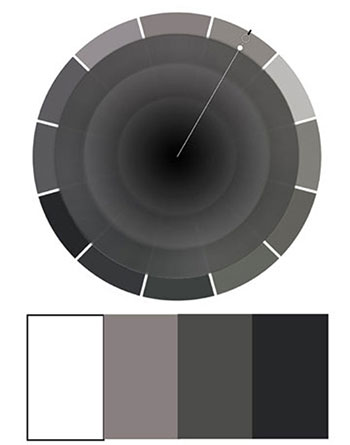
Complementary Colour Scheme:
Colours that are directly opposite to each other in a colour wheel and appear opposite in character are called complementary colours. They create a vibrant effect.
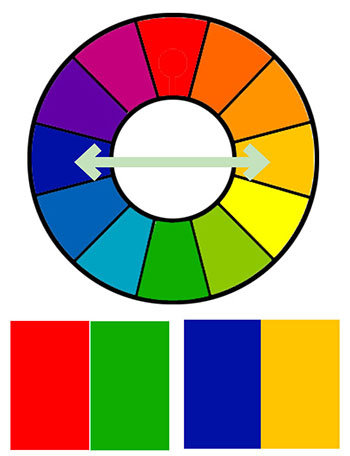
Analogous Colour Scheme:
Analogous colour schemes use colours that are next to each other on the colour wheel. They usually match well and create harmonious effect.
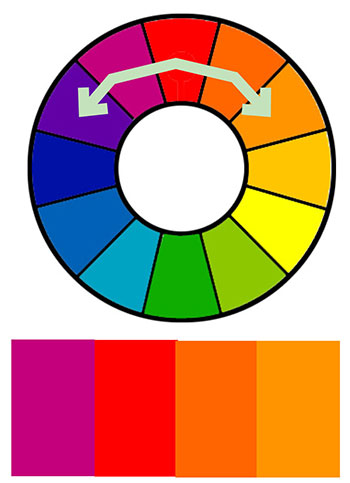
Triadic Colour Scheme:
A triadic colour scheme uses colours that are evenly spaced around the colour wheel.
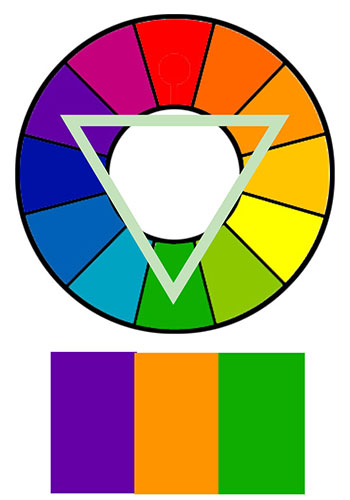
Split-Complementary Colour Scheme:
The split-complementary colour scheme is a variation of the complementary colour scheme. A colour and the two colours adjacent to it’s direct complement. It has high contrast but less contrast than complimentary colours.
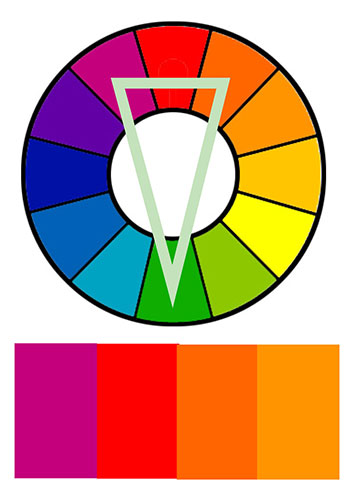
Tetradic Colour Scheme:
The rectangle or tetradic colour scheme uses four colours arranged into two complementary pairs. It offers plenty of possibilities for variation.
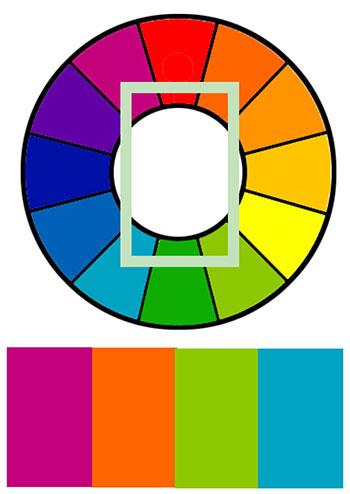
Temperature:
The temperature of a colour is its relative warmth or coolness. Cool colours contain blue or green: blues, greens, violets, and steps between them. Warm colours are reds, oranges, yellow, and steps between them.
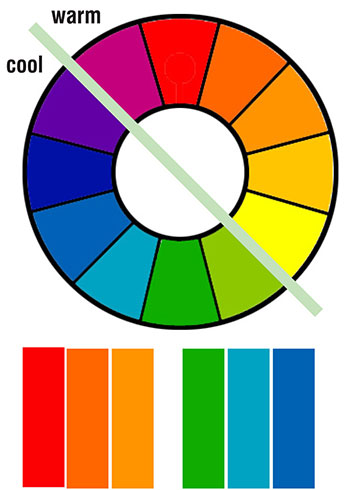
Feisner E. A., (2006) Colour Studies, Fairchild Publication, Inc. NY.
Itten J. (1974) The art of colour: the subjective experience and objective rationale of colour, John Wiley and Sons.
